How to Get Rid of Forehead Wrinkles: 18 Dermatologist-Approved Tips
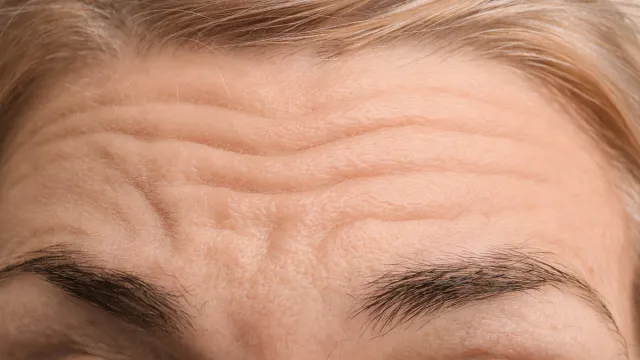
One of the first signs of aging is forehead wrinkles—those pesky lines that appear after you make a facial expression and sometimes linger longer than you’d like afterward. No matter your age, you might be wondering how to get rid of forehead wrinkles and achieve a more youthful appearance. Read on to learn skincare pros’ best tips for easing the appearance of these fine lines and eliminating them altogether.
RELATED: 8 Skincare Ingredients That Help Hide Your Wrinkles, Experts Say.
What Causes Forehead Wrinkles?
Your forehead muscles contract each time you make a facial expression, such as raising your eyebrows or concentrating your brows. After decades of making those same movements, you might begin to notice fine lines or wrinkles in the spots where they occur. Loss of skin elasticity and thinning of the skin caused by decreased collagen production, which occurs naturally with age, add to the wrinkling effect. Years of sun exposure also take their toll.
Are Forehead Lines Reversible?
In most cases, yes. Botox injections and other wrinkle relaxers can help reverse even deep forehead wrinkles. Upgrading your skincare routine to include certain ingredients like retinol can also help, although it won’t be able to eliminate wrinkles completely.
RELATED: 104-Year-Old Woman Reveals Her Anti-Aging Skincare Routine.
How to Get Rid of Forehead Wrinkles
1. Neurotoxin-Based Injectables
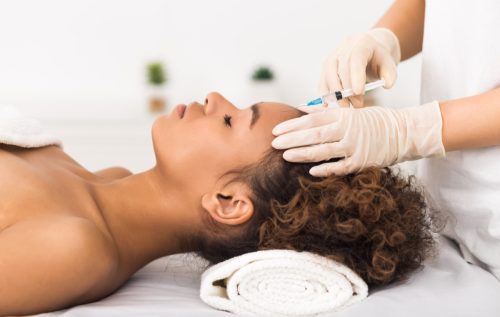
The most proven and effective way to reduce forehead wrinkles is with an injectable.
“Botox, or other brands of wrinkle relaxers like Dysport and Xeomin, function by blocking nerve signals in muscles, leading to temporary weakening or relaxation of the muscle,” says Ginille Brown, NP, aesthetic nurse practitioner and founder of Ginille Beauty Aesthetics. “When it is injected into specific places on the forehead, it prevents them from wrinkling and creating etched lines.”
You’ll need to repeat this procedure a few times a year to maintain its effectiveness and keep forehead lines away.
2. Microneedling
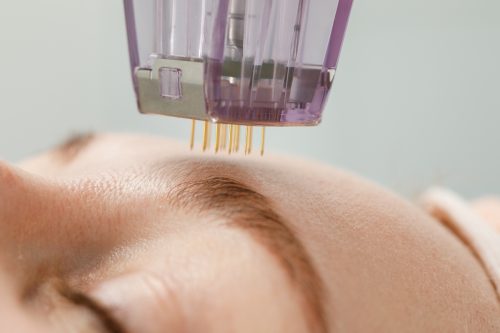
Microneedling helps stimulate collagen production and increase skin renewal.
“During the procedure, tiny needles create micro-injuries in the skin, triggering the body’s natural healing process,” says Alexis Pfropper, licensed esthetician and founder of ästhetik spa. “This leads to increased collagen and elastin production, resulting in smoother, firmer skin and reduced wrinkles over time.”
3. Skin Resurfacing
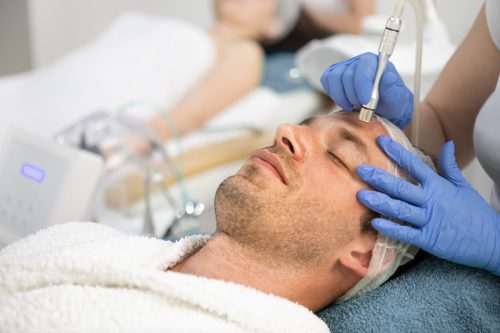
A few treatments fall under this category, says Erica Marie Gatt, esthetician and founder of EM Skin. They include microneedling, microchannelling, lasers, chemical peels, and microdermabrasion.
“It works by removing the outer layer of damaged skin, stimulating collagen production, and promoting the growth of new, smoother skin,” explains Gatt. “Make sure you spread out these treatments by at least four weeks, or you can cause inflammation that worsens the wrinkles.”
4. Laser Treatments
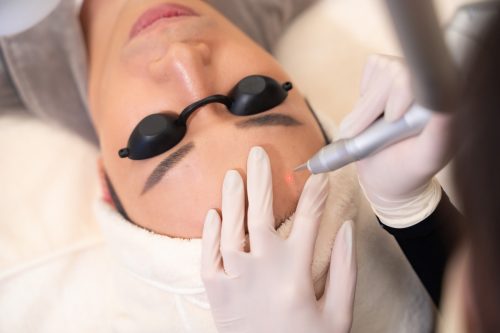
Dermatologists and estheticians use lasers to treat a range of skin concerns, from sun damage and rosacea to scarring and hyperpigmentation.
“Laser treatments for forehead wrinkles work by targeting the deeper layers of the skin with high-energy light beams, which stimulates collagen production and encourages skin tightening,” says Pfropper. “Different types of lasers, such as fractional laser therapy or intense pulsed light (IPL) therapy, can be used depending on the specific needs and severity of the wrinkles.”
Your provider will be able to direct you toward the best one for your needs.
5. Chemical Peels
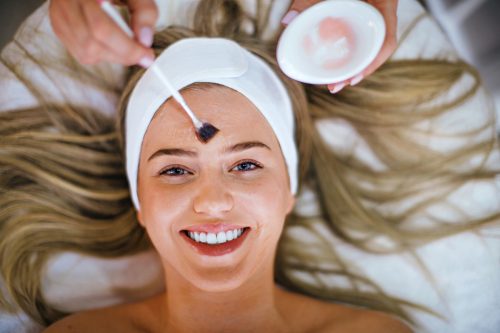
“Chemical peels work to reduce the appearance of forehead wrinkles by exfoliating the outer layer of the skin and promoting cellular turnover,” says Pfropper. “This process removes dead skin cells and stimulates the production of new, healthy skin cells, resulting in smoother texture and diminished wrinkles.”
You may notice redness or flaking after the treatment, which many people prefer to conceal by staying at home for a few days of downtime.
RELATED: 5 Best Anti-Aging Supplements, According to a Doctor.
How to Prevent Forehead Wrinkles Naturally
6. Stay Hydrated

Drinking water can’t eliminate wrinkles, but if you don’t stay hydrated, you’ll notice a poor impact on your health, which could then wreak havoc on skin health. According to the Mayo Clinic, stick to the recommended 15.5 cups for men and 11.5 cups for women. Fruits and vegetables can also help you hydrate.
7. Manage Stress

According to Healthline, stress can change the proteins in the skin and reduce its elasticity, which can cause wrinkles and slash your chances of maintaining a more useful appearance.
8. Don’t Smoke
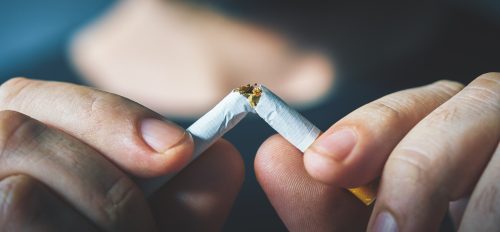
One review of research that studied the link between smoking and skin appearance found that tobacco smoke decreases elasticity and the production of collagen. Quit the habit, and you’ll slow down those processes.
9. Get Regular Exercise

Scientists have found that getting regular exercise can improve skin elasticity and skin thickness.
10. Eat a Balanced Diet

Different nutrients and antioxidants that are found in a balanced diet, like vitamins C and E, protect the skin from the sun and pollution. Adequate protein ensures your body can make collagen, which provides a skin-plumping effect, according to the New York Times.
11. Limit Your Alcohol Consumption

A study of the impact of heavy alcohol use on facial aesthetics found drinking was linked to increased upper facial lines. If you want to minimize those, curbing your alcohol use can help.
12. Wear Lots of Sunscreen
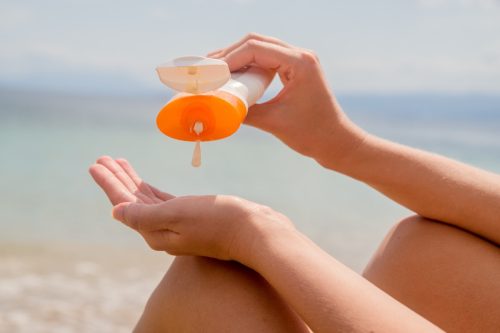
This one is essential. “Wearing sunscreen is absolutely vital to preventing photodamage to the skin from UV rays, which is one of the greatest contributors to collagen loss and skin aging,” says Marina Sominsky, RN, owner of Capital Aesthetics.
RELATED: Never Buy Skincare Products With These 5 Ingredients, Dermatologists Warn.
Skincare Products to Reduce Forehead Lines
13. Retinoids
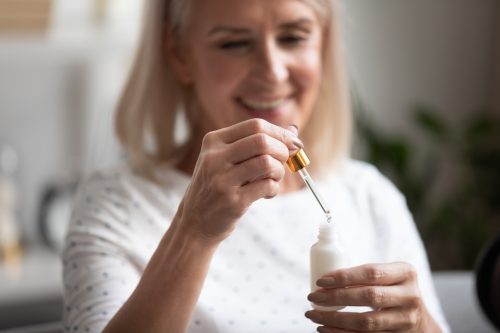
This is one of the only skincare products that can produce visible, measurable results.
“As a derivative of vitamin A, retinol is a strong acid that works to increase cell turnover and help block the production of the enzyme that breaks down your skin’s collagen over time,” says Sominsky. “Collagen is responsible for skin elasticity, which means retinol can help sustain the firmness and plumpness of the skin, making your appearance stay youthful longer.”
Talk to your dermatologist about the right one to introduce into your routine and how to apply it for the best results.
14. Peptides
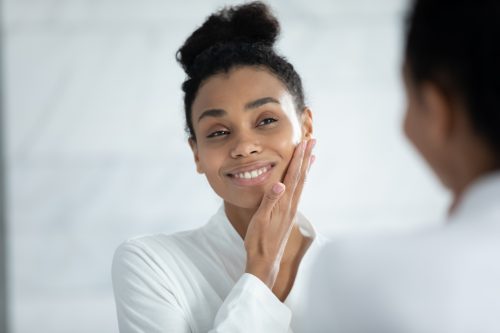
You’ll likely see peptides advertised on a range of moisturizers and serums—and they’re helpful in the fight against wrinkles.
“Peptides are small chains of amino acids that signal the cells to perform specific functions, such as producing collagen, which improves skin elasticity and firmness,” says Gatt.
15. Antioxidants

Antioxidants take a unique approach to wrinkle prevention. “They kill free radicals, which can cause damage to the skin’s collagen and elastin fibers, which is the cause of wrinkles and fine lines,” says Gatt. Look for ones like vitamins E and C.
16. Vitamin C

Vitamin C is an antioxidant used to prevent changes associated with sun damage and hyperpigmentation. It is available in serum form.
17. Hyaluronic Acid
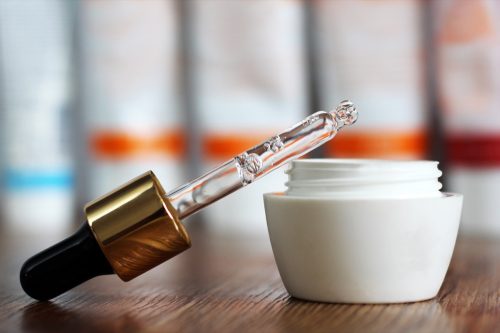
This ingredient can reduce the appearance of wrinkles in the short term by adding hydration.
“Hyaluronic acid is a humectant, which means it attracts and retains moisture from the environment and helps to hydrate the skin,” explains Gatt. “When you increase skin hydration, it can temporarily diminish the appearance of wrinkles on the forehead, making your skin look plump and youthful.”
18. Primer

Applying primer underneath your makeup can lay a smooth foundation for other products. It can also help hydrate the skin, which minimizes the appearance of lines.
RELATED: 8 Skincare Mistakes That Make You Look Older.
What’s the Ideal Age to Begin Treating Forehead Wrinkles?
The best answer is whenever you’re ready! “That’s what I advise patients because the ideal timing varies based on individual factors such as lifestyle and aesthetic preferences,” shares Brown. “Many individuals begin noticing early signs of aging, such as fine lines on the forehead or around the eyes, persistent dark spots from sun exposure, or changes in skin texture due to acne scarring, typically in their late 20s to early 30s.”
If you start treatments then, it might be easier to reverse, as opposed to waiting until the changes are more intense. You can also get advice from the pros.
“One of my top recommendations is to consult with a provider, or multiple providers, to find the right fit before undergoing any treatment,” Brown adds. “It’s crucial to ask questions about recommended procedures, such as ‘Why is this treatment suitable for me?’ ‘What realistic results can I expect?’ ‘What are the potential risks, and how would we address any undesired outcomes?’ and ‘What steps can I take for optimal results and maintenance?'”
Why You Can Trust Best Life
Best Life consults the top dermatologists, estheticians, and aesthetic practitioners to bring you the most accurate and up-to-date information. We also include research from peer-reviewed journals to bring our readers the newest science.
Conclusion
There are several ways to maintain smooth skin, from skincare upgrades to injectables. Consult with a dermatologist to devise the best plan for you. And for more skincare advice, visit Best Life again soon.
- Source: Mayo Clinic: Water: How much should you drink every day?
- Source: Journal of Dermatological Science: Tobacco smoke causes premature skin aging
- Source: Scientific Reports: Resistance training rejuvenates aging skin...
- Source: The Journal of Clinical and Aesthetic Dermatology: Impact of Smoking and Alcohol Use on Facial Aging in Women
- Source: Indian Dermatology Online Journal: Vitamin C in dermatology